blacktruck
Member
After a discussion on another thread about props, it was suggested to move the discussion to a different thread. This piece was posted on Scream and Fly and written by Jim Russel from Aeromarine Research. The original discussion revolved around the idea that with an elevated engine height; prop blades (one blade) experience a full load, while the other blades experienced an unloaded situation. One person commented that the unloading was dramatic. But it's accurate and this article discusses why. When an in-balance in pressure is experienced it results in propeller blowout, or "propeller burn" prior to blowout.
- From Scream and Fly
By Jim Russell, P. Eng, Aeromarine Research
I receive many questions about the cause and effects of "blowout". Here is an explanation of blowout and causes and cures.
Most all high-performance boaters have experienced the circumstance that restricts their maximum velocity to less than it could be, even though they’ve got the horsepower available to use. This phenomenon is commonly called "gearcase blowout” or "propeller blowout".
Blowout occurs when something causes air/water mixture in the region of the propeller to become sufficiently disturbed that the propeller cannot continue working in “clean” water, but is rather, trying to work through a very soft or light mixture (or a relative vacuum). This causes the propeller efficiency to significantly fall off, (seems to lose its “grip” or loses thrust) and triggers a typically dramatic hull performance behavior. These behaviors can vary from a feeling of "loose" steering to a nasty ferocious turn. The velocity at which “blowout” takes place depends on boat design, hull setup, lower unit design, propeller design, and driving style.
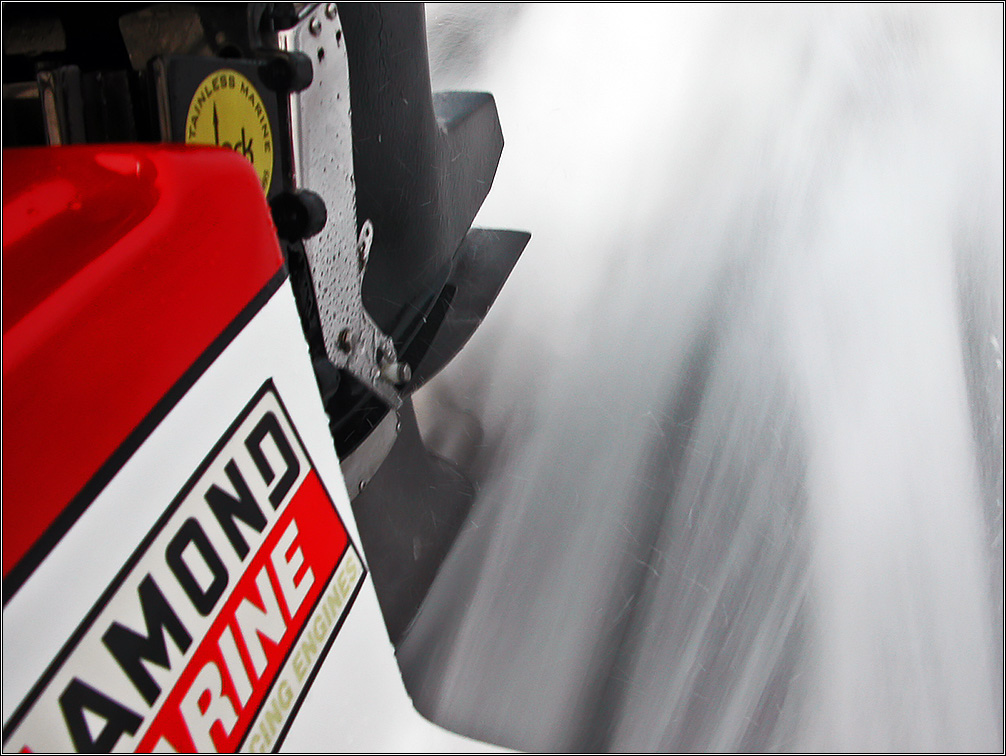
Motor Height:
If the engine is positioned too high on the motor mount or transom, the propeller may not generate sufficient lift for the boat. This usually requires that the driver then apply excessive trim (out). This, in turn, causes the direction of thrust of the propeller to be less than optimum - inclined downward instead of aligned exactly in the direction of motion (parallel to the water surface). This trim angle is thus forcing a most inefficient profile to the hydrodynamic flow around the lower unit (more drag) and the propeller (inefficient lift). This is bad for the propeller, and inefficient for the boat performance. Designing the hull and the boat setup with the engine at the optimum height will help overall performance.
Using a jack plate will make these engine adjustments much easier. This is easiest to do with a hydraulic jack plate, but a manual jack plate will provide the same range of adjustment needed. A hydraulic jack allows you to adjust the engine height while in full flight – the best of all worlds! This is the safest feature of the hydraulic engine jack, because it eliminates the need to “compromise” your engine setup. [Remember that as you raise the engine height, a low water pickup may become necessary in order to ensure that the engine gets enough water pressure.]
The best setup will be the one where your lower unit bullet is parallel with the water surface – not trimmed (angled) upwards or downwards.Test your rig at different speeds and water conditions to find the best height for each. You will find that different operating conditions will benefit from different engine heights, which is another good reason for using a hydraulic jack plate. Often, as the engine is raised on the transom, the reduced lower unit drag can allow for a different trim angle to be applied, resulting in an improved effect on the speed at which the onset of blowout will occur. Engine setback can also affect stability, although it is more difficult to test using the ‘trial and error” method.
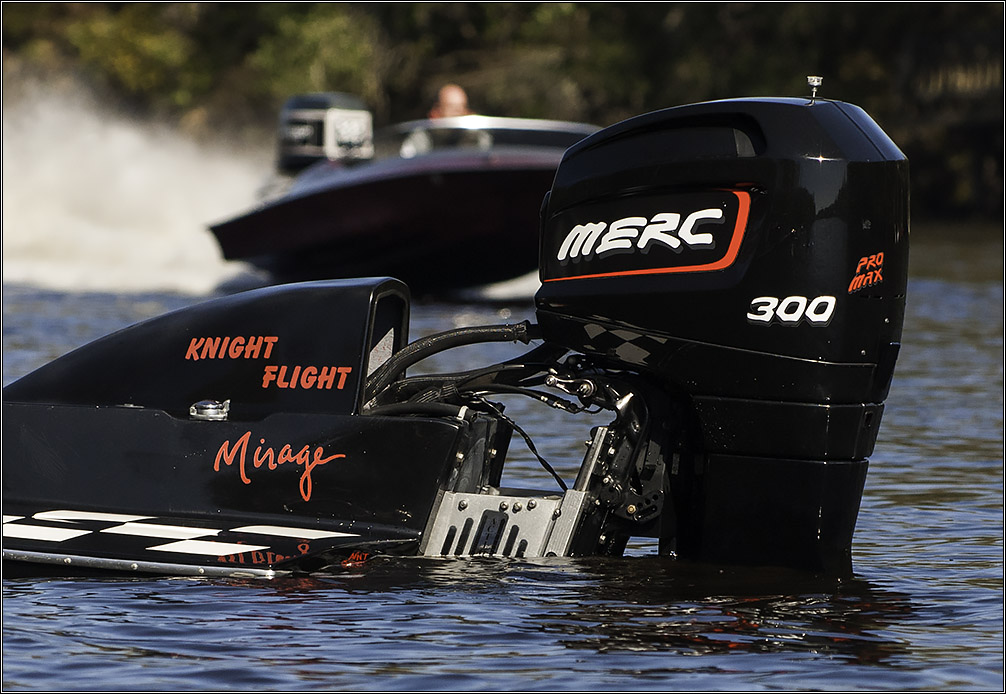
Gear Case Condition:
If the gear case has been damaged (tagged any logs or rocks lately?) or has an improperly installed nosecone; or a damaged skeg; the gear case cannot maintain the intended hydrodynamic direction (steering). The performance impact can be the desire (need) for the gear case to "crab" through the water, creating an area void of pure water, like an air pocket where the propeller is now trying to properly perform its duty. This is bad news for the propeller - it needs good ‘solid’ water to work properly. Cleaning up all the scratches, scrapes, nicks and gouges in the gear case so that it is very smooth will improve performance. If you are experiencing some symptoms of ‘blowout’ you’ll be surprised how cleaning up the condition of your gear case can magically improve (delay) the onset of the blowout occurrence.
Ensure that the nosecone (if added to OEM gearcase) is properly installed, that it is straight, with no ridges or epoxy bubbles, etc. Make sure that your skeg is whole and undamaged, with no nicks or gouges. Don’t underestimate the possible significance of this operation – the smallest and seemingly trivial defects in the gear case surfaces can trip the “onset of blowout”!
Hull Design:
Some hull designs are more susceptible to blowout than others are. As with much of boat design, there are no definitive rules for how to design for “no blowout”, since there are so many operating and performance issues that the designer must take into consideration. It’s difficult to merely look at your boat to determine whether it might be susceptible to “premature onset of blowout” or not. The well-designed hull will have a dynamically balanced performance through all phases of performance (all operating speeds). The inherently unstable hull will need much more time and effort for "on the water" set-up. It is, of course, better to design the stability and performance characteristics into your hull ahead of time…this makes the set-up much easier, and the hull performance more predictable in all operating conditions. But sadly, this is not always the case, and effective setup can really help to delay the onset of premature blowout. Weight distribution, engine positioning, bottom cleanliness are some features that can be altered, if need be, after the boat is diagnosed with problems. The hull that is dynamically stable throughout its uppermost velocity range can reduce the tendency for blowout and also minimize the otherwise dramatic effects of the blowout occurrence.
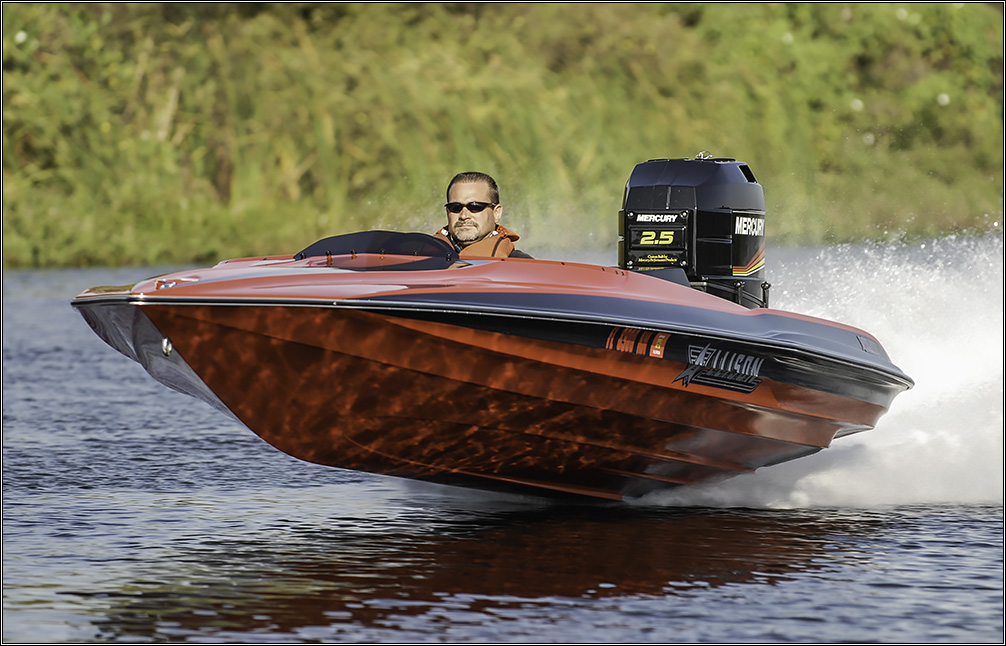
Once a stock gear case is asked to go faster than the speed for which it was originally designed to perform, water separates from the leading edge of the rounded bullet and upsets the flow around the propeller. In engineering terms, this is a disturbed flow, and when this occurs near the propeller, it really impacts the propeller's performance and efficiency. Smaller gear cases with smaller, more aerodynamic bullets will always improve this situation, delaying "blowout" tendencies to a higher velocity. Adding a nosecone can also increase the velocity (delay the onset of blowout) that a standard gear case can operate effectively (more on nosecones later).The cause of blowout is generally a combination of all of these sources. Gear case modifications and propeller changes can reduce your chance of blowout or reduce the tendencies for blowout, or delay the onset of blowout (velocity). A properly designed and dynamically balanced hull also helps the blowout situation. The reality of high performance powerboating is, however, that as you strive for the maximum performance of your setup, blowout is often just piece of the business, so you will experience it eventually.
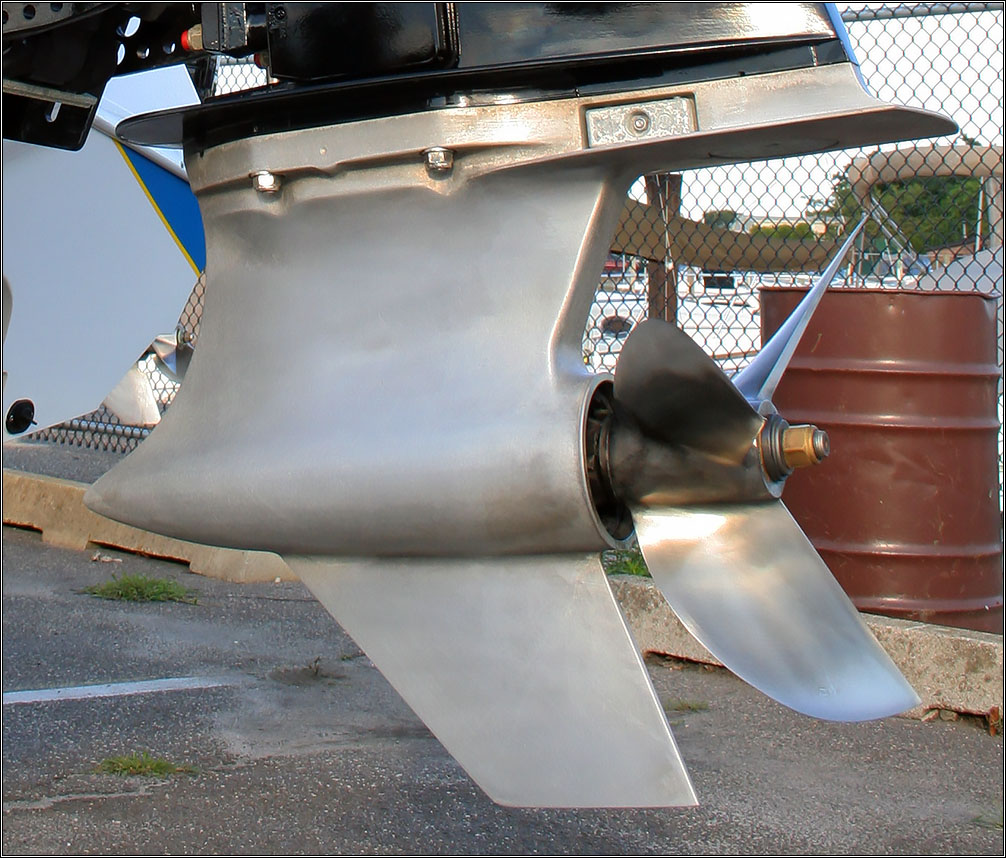
Nose-Cone Technology:
As water flows by the lower unit and begins to separate from the unit at higher speeds, a turbulent flow condition or "vortex" causes a (relative) vacuum (or lower pressure) behind the gear case. This lower pressure increases the drag of the lower unit. A by-product of the air/water mixture and the water separation from the gearcase surfaces is propeller burning. This phenomenon leads to blow-out, and can also reduce top speed before blow-out is obtained. By increasing the length of the bullet on the lower unit, the hydrodynamic aspect ratio (length to diameter ratio) of the bullet is increased (improved), providing superior water flow characteristics and delaying the onset of propeller burn and blowout.A well-designed nose cone can delay the speed at which blow-out occurs and improve propeller efficiency.
Cavitation Is Not Blowout:
But we always get it! Cavitation is the sudden formation and collapse of low-pressure bubbles in liquids in regions of very low pressure or regions that are subjected to rapid or intense pressure changes. The design of a gearcase is a compromise hydrodynamically. This is because the lower unit must be big enough to contain gears, exhaust, water intakes, etc. – and that makes it challenging to design the shape to be as hydrodynamically perfect as we’d like. On the outside surfaces of the gearcase are the fill holes, drain holes, water vents, etc. – and any disturbance of the flow of water on a gearcase can cause cavitation as the speed of the boat increases.
Cavitation itself does not cause the blowout. Blowout occurs when existing cavitation bubbles travel back to the trailing end of the torpedo and meet up with the engine exhaust gases. Once this happens the exhaust floods over the low-pressure side (depends on left/right prop rotation) of the gearcase. The mixture also flows back into the propeller blades. The result is a sudden and drastic reduction of lift and thrust generated by the low-pressure side of the propeller blades – blowout.
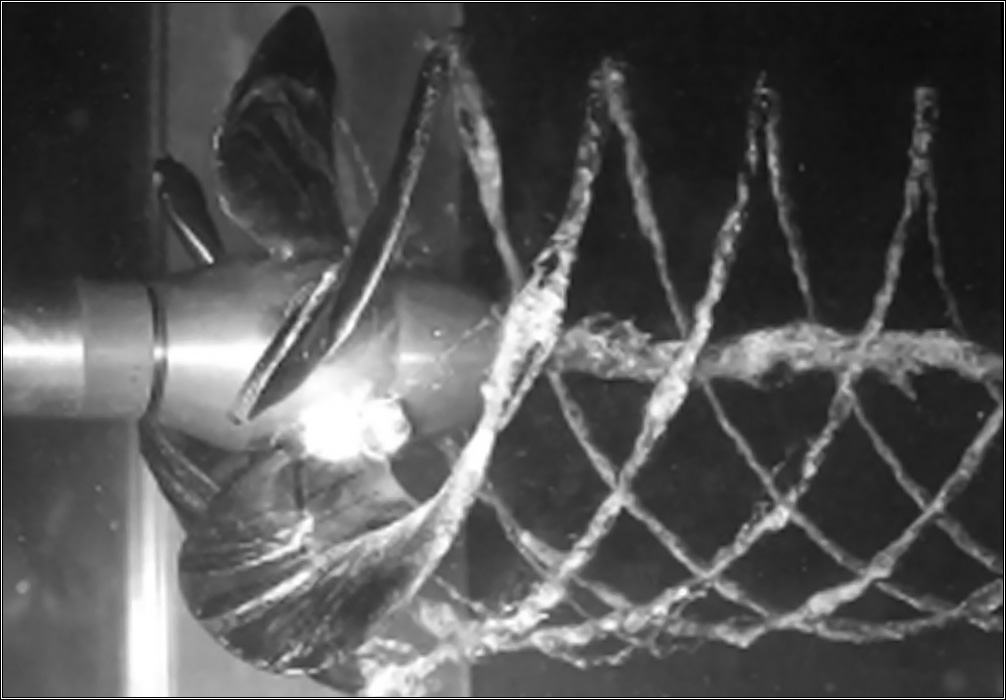
You might not even have blowout. Very few boats run into a total blowout situation; more often the setups encounter "propeller burn" - a phenomenon that occurs prior to blow-out. Many high performance boaters may be experience propeller burn and not even be aware of it. You may have noticed pitting on your propeller blades caused by this propeller burn. The addition of a nose cone can reduce or even eliminate propeller burn, blow-out, and allow you to improve your speed if the horsepower is available.
When blowout does occur, the blades no longer have the clean water needed for energy transfer through the water. The propeller breaks loose completely and cannot recover until the boat is slowed down enough to allow water to re-enter the propeller void created by the ventilation occurrence.
Blowout can sneak up on you! Classically, just prior to encountering a blowout you will experience a loose steering feeling, an RPM increase without any speed increase, a loss of lift, and a resulting drop of the bow of the boat. When all of these happen quickly, it can be a hair-raising incident! With experience, you can learn to sense when you are approaching the onset of blowout…so pay close attention, take appropriate actions, always wear your PFD…and hold on!
Further Reading:
Read more about performance vee hull and tunnel boat design and setup in the world acclaimed "Secrets of Tunnel Boat Design" book and the new "Tunnel Boat/Vee Hull Design Program", Version 8 - world's only computer software dedicated to design and performance analysis of Tunnel hulls and performance Vee hulls.
Links For Reference:
The "Secrets of Tunnel Boat Design" book (ISBN 1-894933-30-3), "Secrets of Propeller Design" book (ISBN 0-9780586-0-7), “Tunnel Boat Design” software, “Vee Boat Design” software, and "PropWorks2" software are available at AeroMarine Research.
- From Scream and Fly
By Jim Russell, P. Eng, Aeromarine Research
I receive many questions about the cause and effects of "blowout". Here is an explanation of blowout and causes and cures.
Most all high-performance boaters have experienced the circumstance that restricts their maximum velocity to less than it could be, even though they’ve got the horsepower available to use. This phenomenon is commonly called "gearcase blowout” or "propeller blowout".
Blowout occurs when something causes air/water mixture in the region of the propeller to become sufficiently disturbed that the propeller cannot continue working in “clean” water, but is rather, trying to work through a very soft or light mixture (or a relative vacuum). This causes the propeller efficiency to significantly fall off, (seems to lose its “grip” or loses thrust) and triggers a typically dramatic hull performance behavior. These behaviors can vary from a feeling of "loose" steering to a nasty ferocious turn. The velocity at which “blowout” takes place depends on boat design, hull setup, lower unit design, propeller design, and driving style.
Blowout occurs when the propeller's 'bite' is disrupted.
The Main Contributors To Blowout
The Main Contributors To Blowout
Motor Height:
If the engine is positioned too high on the motor mount or transom, the propeller may not generate sufficient lift for the boat. This usually requires that the driver then apply excessive trim (out). This, in turn, causes the direction of thrust of the propeller to be less than optimum - inclined downward instead of aligned exactly in the direction of motion (parallel to the water surface). This trim angle is thus forcing a most inefficient profile to the hydrodynamic flow around the lower unit (more drag) and the propeller (inefficient lift). This is bad for the propeller, and inefficient for the boat performance. Designing the hull and the boat setup with the engine at the optimum height will help overall performance.
Using a jack plate will make these engine adjustments much easier. This is easiest to do with a hydraulic jack plate, but a manual jack plate will provide the same range of adjustment needed. A hydraulic jack allows you to adjust the engine height while in full flight – the best of all worlds! This is the safest feature of the hydraulic engine jack, because it eliminates the need to “compromise” your engine setup. [Remember that as you raise the engine height, a low water pickup may become necessary in order to ensure that the engine gets enough water pressure.]
The best setup will be the one where your lower unit bullet is parallel with the water surface – not trimmed (angled) upwards or downwards.Test your rig at different speeds and water conditions to find the best height for each. You will find that different operating conditions will benefit from different engine heights, which is another good reason for using a hydraulic jack plate. Often, as the engine is raised on the transom, the reduced lower unit drag can allow for a different trim angle to be applied, resulting in an improved effect on the speed at which the onset of blowout will occur. Engine setback can also affect stability, although it is more difficult to test using the ‘trial and error” method.
A jack plate makes engine height adjustment easy.
Gear Case Condition:
If the gear case has been damaged (tagged any logs or rocks lately?) or has an improperly installed nosecone; or a damaged skeg; the gear case cannot maintain the intended hydrodynamic direction (steering). The performance impact can be the desire (need) for the gear case to "crab" through the water, creating an area void of pure water, like an air pocket where the propeller is now trying to properly perform its duty. This is bad news for the propeller - it needs good ‘solid’ water to work properly. Cleaning up all the scratches, scrapes, nicks and gouges in the gear case so that it is very smooth will improve performance. If you are experiencing some symptoms of ‘blowout’ you’ll be surprised how cleaning up the condition of your gear case can magically improve (delay) the onset of the blowout occurrence.
Ensure that the nosecone (if added to OEM gearcase) is properly installed, that it is straight, with no ridges or epoxy bubbles, etc. Make sure that your skeg is whole and undamaged, with no nicks or gouges. Don’t underestimate the possible significance of this operation – the smallest and seemingly trivial defects in the gear case surfaces can trip the “onset of blowout”!
Hull Design:
Some hull designs are more susceptible to blowout than others are. As with much of boat design, there are no definitive rules for how to design for “no blowout”, since there are so many operating and performance issues that the designer must take into consideration. It’s difficult to merely look at your boat to determine whether it might be susceptible to “premature onset of blowout” or not. The well-designed hull will have a dynamically balanced performance through all phases of performance (all operating speeds). The inherently unstable hull will need much more time and effort for "on the water" set-up. It is, of course, better to design the stability and performance characteristics into your hull ahead of time…this makes the set-up much easier, and the hull performance more predictable in all operating conditions. But sadly, this is not always the case, and effective setup can really help to delay the onset of premature blowout. Weight distribution, engine positioning, bottom cleanliness are some features that can be altered, if need be, after the boat is diagnosed with problems. The hull that is dynamically stable throughout its uppermost velocity range can reduce the tendency for blowout and also minimize the otherwise dramatic effects of the blowout occurrence.
A well-designed hull will have dynamically balanced performance at all speeds.
Velocity:
Once a stock gear case is asked to go faster than the speed for which it was originally designed to perform, water separates from the leading edge of the rounded bullet and upsets the flow around the propeller. In engineering terms, this is a disturbed flow, and when this occurs near the propeller, it really impacts the propeller's performance and efficiency. Smaller gear cases with smaller, more aerodynamic bullets will always improve this situation, delaying "blowout" tendencies to a higher velocity. Adding a nosecone can also increase the velocity (delay the onset of blowout) that a standard gear case can operate effectively (more on nosecones later).The cause of blowout is generally a combination of all of these sources. Gear case modifications and propeller changes can reduce your chance of blowout or reduce the tendencies for blowout, or delay the onset of blowout (velocity). A properly designed and dynamically balanced hull also helps the blowout situation. The reality of high performance powerboating is, however, that as you strive for the maximum performance of your setup, blowout is often just piece of the business, so you will experience it eventually.
A nose cone can delay the onset of blowout.
Nose-Cone Technology:
As water flows by the lower unit and begins to separate from the unit at higher speeds, a turbulent flow condition or "vortex" causes a (relative) vacuum (or lower pressure) behind the gear case. This lower pressure increases the drag of the lower unit. A by-product of the air/water mixture and the water separation from the gearcase surfaces is propeller burning. This phenomenon leads to blow-out, and can also reduce top speed before blow-out is obtained. By increasing the length of the bullet on the lower unit, the hydrodynamic aspect ratio (length to diameter ratio) of the bullet is increased (improved), providing superior water flow characteristics and delaying the onset of propeller burn and blowout.A well-designed nose cone can delay the speed at which blow-out occurs and improve propeller efficiency.
Cavitation Is Not Blowout:
But we always get it! Cavitation is the sudden formation and collapse of low-pressure bubbles in liquids in regions of very low pressure or regions that are subjected to rapid or intense pressure changes. The design of a gearcase is a compromise hydrodynamically. This is because the lower unit must be big enough to contain gears, exhaust, water intakes, etc. – and that makes it challenging to design the shape to be as hydrodynamically perfect as we’d like. On the outside surfaces of the gearcase are the fill holes, drain holes, water vents, etc. – and any disturbance of the flow of water on a gearcase can cause cavitation as the speed of the boat increases.
Cavitation itself does not cause the blowout. Blowout occurs when existing cavitation bubbles travel back to the trailing end of the torpedo and meet up with the engine exhaust gases. Once this happens the exhaust floods over the low-pressure side (depends on left/right prop rotation) of the gearcase. The mixture also flows back into the propeller blades. The result is a sudden and drastic reduction of lift and thrust generated by the low-pressure side of the propeller blades – blowout.
Cavitation precedes blowout.
You might not even have blowout. Very few boats run into a total blowout situation; more often the setups encounter "propeller burn" - a phenomenon that occurs prior to blow-out. Many high performance boaters may be experience propeller burn and not even be aware of it. You may have noticed pitting on your propeller blades caused by this propeller burn. The addition of a nose cone can reduce or even eliminate propeller burn, blow-out, and allow you to improve your speed if the horsepower is available.
When blowout does occur, the blades no longer have the clean water needed for energy transfer through the water. The propeller breaks loose completely and cannot recover until the boat is slowed down enough to allow water to re-enter the propeller void created by the ventilation occurrence.
Blowout can sneak up on you! Classically, just prior to encountering a blowout you will experience a loose steering feeling, an RPM increase without any speed increase, a loss of lift, and a resulting drop of the bow of the boat. When all of these happen quickly, it can be a hair-raising incident! With experience, you can learn to sense when you are approaching the onset of blowout…so pay close attention, take appropriate actions, always wear your PFD…and hold on!
Further Reading:
Read more about performance vee hull and tunnel boat design and setup in the world acclaimed "Secrets of Tunnel Boat Design" book and the new "Tunnel Boat/Vee Hull Design Program", Version 8 - world's only computer software dedicated to design and performance analysis of Tunnel hulls and performance Vee hulls.
Links For Reference:
The "Secrets of Tunnel Boat Design" book (ISBN 1-894933-30-3), "Secrets of Propeller Design" book (ISBN 0-9780586-0-7), “Tunnel Boat Design” software, “Vee Boat Design” software, and "PropWorks2" software are available at AeroMarine Research.



 So now you knew all along why blowout happens, but were just pretending not to know before?? Very strange.
So now you knew all along why blowout happens, but were just pretending not to know before?? Very strange. 